Just like that, another earnings season is upon us. This time it’s a big one too: Q4 2017, the final performance report for 2017.
Many companies will be reporting both quarterly as well as annual numbers. CEOs often also take more time during the Q4 earnings call to discuss the past as they look back on the year's successes and provide a forecast for the future as a way of inspiring investor confidence, and share purchases, for the year ahead.
This earnings season we'll provide a weekly preview of notable earnings reports scheduled for the week ahead. We'll highlight the numbers to watch and what to expect from the market's biggest and in our view most interesting companies.
Here are the five earnings reports to watch during the week of January 15-19:
1. United Health
Reports Tuesday, January 16, Before the Open
- Revenue expectation: $51.52B; EPS: $2.50
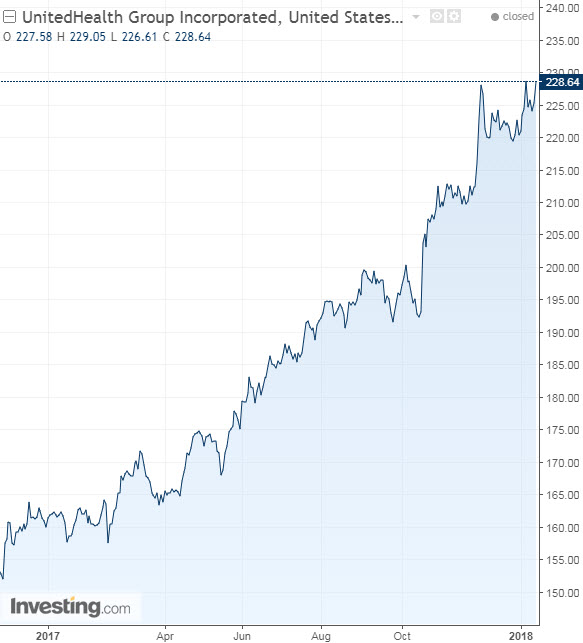
UnitedHealth (NYSE:UNH) is a diversified healthcare provider, specializing in health care coverage and benefits, as well as delivering actual health care services. The Healthcare sector is heating up and companies have been consolidating via a wave of mergers. Share prices have been rising throughout 2017.
Among the headline consolidations: CVS Health (NYSE:CVS) intends to purchase Aetna (NYSE:AET) for $69 billion; Humana (NYSE:HUM) obtained a 40% stake in Kindred's (NYSE:KND) home care business and United Health announced on December 6 that it is buying DaVita HealthCare Partners' (NYSE:DVA) primary care units for $4.9 billion. With a market cap of over $217 billion, United Health is well positioned as one of the primary players in the Healthcare industry. 2017 was a very good year for UNH. Its shares rose 37%, from $161 to $220.
The company's revenues have grown at least 7.5% every quarter in 2017. In addition, because they left the ACA marketplace, United Health is relatively safe from any volatility generated by the Trump administration's ongoing efforts to dismantle the Affordable Care Act and they're now more robustly equipped to face any changes wrought by the shifting political landscape.
The company is fundamentally sound and although its debt levels have been expanding, its EBITDA has been rising as well, allowing it to not be excessively leveraged. The Healthcare sector will continue to change in 2018, but United Health looks to be positioned as one of the better companies in the sector.
2. Bank of America
Reports Wednesday, January 17, Before the Open
- Revenue Expectation: $21.3B; EPS: $0.44
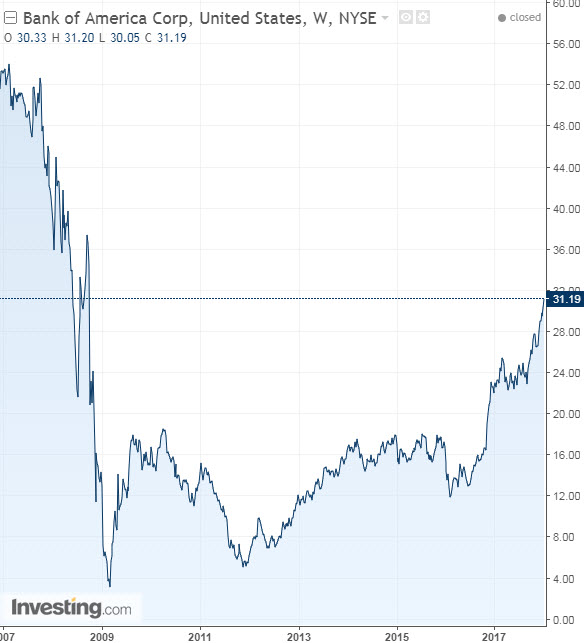
Bank of America (NYSE:BAC) is on a roll of historic proportions. It just reached $30 dollar per share, for the first time since the 2008 financial crisis.
Bank of America is a very different entity from its pre-crisis self. The days of its prominence in mortgage lending are largely gone. Regulations—enacted since the great financial meltdown, ensure that banks can't nor won't take on added financial risks, as they once did before the crash—remain in place, although the Trump administration is keen on repealing some of these.
As a rule, bank stocks are often slower to move. Over the past decade, BAC has been the perfect example of how slowly improving macro-economic conditions will trickle down to impact banks' top and bottom lines. Three or more rate hikes in 2018, as well as improving US GDP growth, should continue to push BAC higher.
In general, bank stock performance tends to reflect two things: the regulatory environment and the state of the economy. Easing the regulatory burden alongside a robust economy are the perfect ingredients for a good year for banks. We think a small earnings beat is not out of the question for BAC in Q4.
3. Goldman Sachs
Reports Wednesday, January 17, Before the Open
- Revenue Expectation: $7.61B; EPS: $4.89
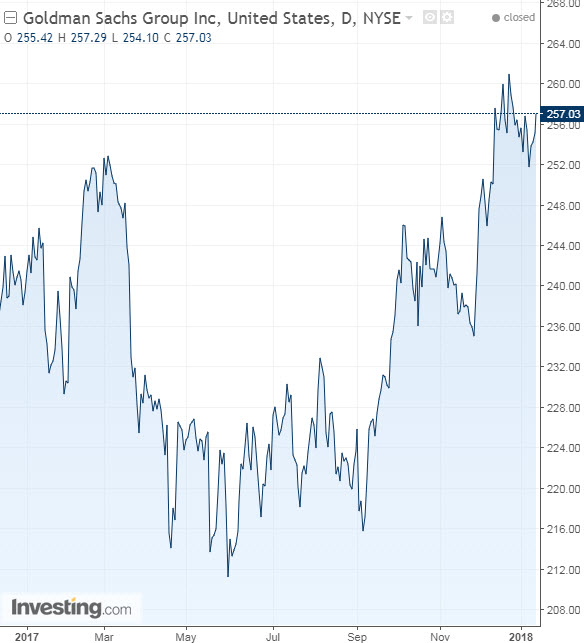
Goldman Sachs (NYSE:GS) is an investment bank and a securities and investment management firm.
First, the bad news. In late December, Goldman Sachs estimated that the newly enacted US tax legislation could reduce its Q4 earnings by about $5 billion. Most of the negative impact relates to the just passed repatriation portion of the tax law since it appears they could be bringing offshore profits home and will have an increased tax liability as a result.
This throws a spanner into any previous predictions regarding Goldman Sachs' performance in the fourth quarter and could cause the company to post a loss of about $3 billion for the quarter, should reconfigured estimates be accurate.
The longer term problem with Goldman is its expected growth rate. The investment bank is expected to grow at only 1.7% annually on earnings. Trading revenues have been down lately; fixed income trading – GS's biggest unit from a revenue producing standpoint – saw a 26% quarterly decline year-over-year.
The next breakthrough quarter from an earnings perspective isn't expected until Q4 2018, a year from now. This is also the estimated timeframe for a resurgence in Goldman's trading revenue. Until then its M&A division and financial asset management group are expected to hold down the fort.
This could be a year of stagnating earnings for Goldman. During Wednesday's earnings call we'll be listening for comments on growth.
4. International Business Machines
Reports Thursday, January 18, After the Close
- Revenue Expectation: $21.94B; EPS: $5.16
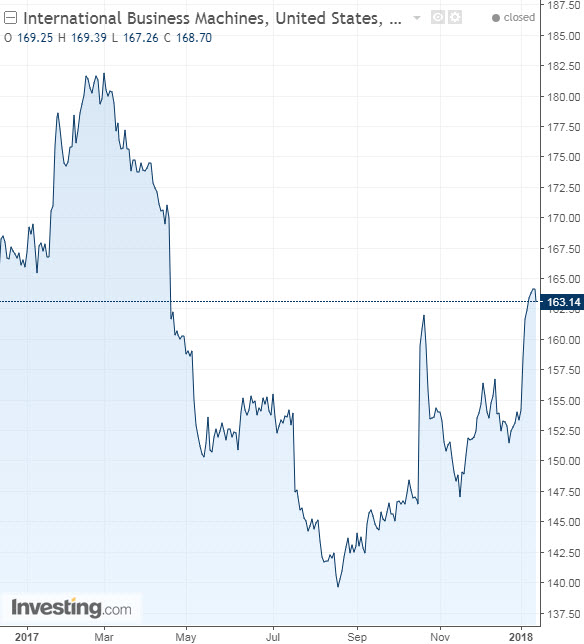
In an article last week called 5 Stocks To Watch In 2018, we singled out International Business Machines (NYSE:IBM), saying that we believe the company will be at a crossroad in 2018. The biggest question we have going into Q4 is can IBM stop its negative streak of 22 consecutive revenue declines? If estimates are correct, IBM will indeed report growth of 0.7% year-over-year, putting at least a temporary end to its lengthy revenue slide.
There could be some serious volatility awaiting IBM after its Q4 report. News that it has finally been able to reverse its revenue slump should send the stock higher, while another disappointment could propel the stock even lower, weighing on its price more sharply than if the expectation had been simply for another quarter of declines.
During the conference call, regardless of the results, we'll be looking for any indication of short and longer term growth engines that IBM plans to rely on to help the company expand. Almost two years ago we said:
"If IBM wants to avoid obsolescence and be reborn, it needs something convincing to distance itself from the competition. We are still waiting for a clear plan showing how this will happen, even after two years of what the company has called 'aggressive' repositioning".
Is IBM any closer now than it was two or even four years ago to some form of reinvention? Sadly, the answer is no.
5. Schlumberger
Reports Friday, January 19, Before the Open
- Revenue Expectation: $8.13B; EPS: $0.44
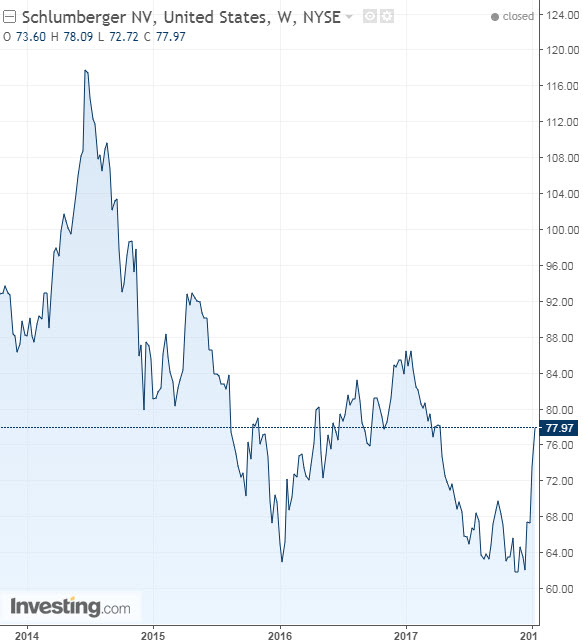
Schlumberger (NYSE:SLB) is the world's largest oilfield services company, focused on enabling drillers through technology, equipment, and rig maintenance. The first thing to note about upcoming earnings from any oil and gas sector operation is that WTI has finally pulled out of its long price slump, rallying from $42 a barrel in June, to $64 a barrel today.
The outlook for Schlumberger, provided by Chairman and CEO Paal Kibsgaard in Q3, was positive. It pointed to strong oil demand and global GDP growth as major factors in Schlumberger's 2018 forecast. That proved true, for a while. But, after a period of sustained growth, the weekly rig count has stagnated, even though oil prices are rising. This remains a critical metric in order to effectively evaluate Schlumberger's macro conditions. We'll have to wait and see how this potential speed bump plays out.
Overall, the company is in the midst of a recovery. During its best bottom line year, 2013, Schlumberger saw $46B in revenue, and $6.7B in net profits. Over the past twelve months, those numbers dropped to $29B and $545M, a decline of 37% and 91%, respectively. If it has a good report, Schlumberger will be able to post an entire year of positive revenue growth in every single quarter, something that hasn't happened since…2013. Continued recovery and improving growth prospects could bring Schlumberger's shares – currently trading at $77.97 from a low of $61.02 in November – back in a big way.
